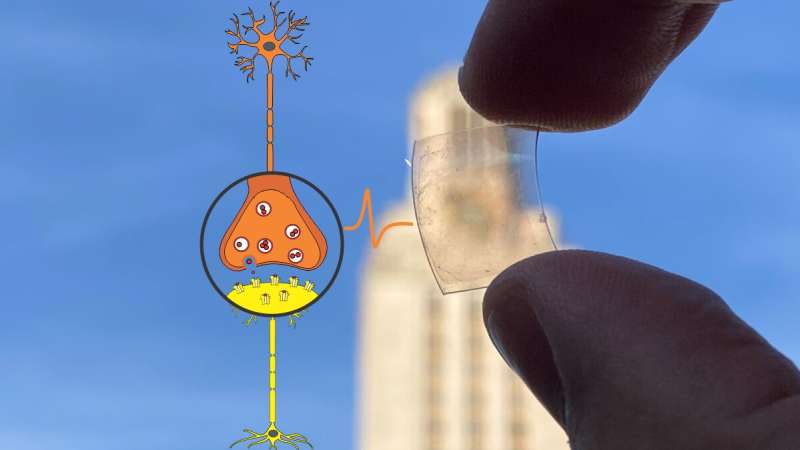
Computers that think more like human brains are inching closer to mainstream adoption. But many unanswered questions remain. Among the most pressing, what types of materials can serve as the best building blocks to unlock the potential of this new style of computing.
For most traditional computing devices, silicon remains the gold standard. However, there is a movement to use more flexible, efficient and environmentally friendly materials for these brain-like devices.
In a new paper, researchers from The University of Texas at Austin developed synaptic transistors for brain-like computers using the thin, flexible material graphene. These transistors are similar to synapses in the brain, that connect neurons to each other.
“Computers that think like brains can do so much more than today’s devices,” said Jean Anne Incorvia, an assistant professor in the Cockrell School of Engineering’s Department of Electrical and Computer Engineer and the lead author on the paper published today in Nature Communications. “And by mimicking synapses, we can teach these devices to learn on the fly, without requiring huge training methods that take up so much power.”
The research
A combination of graphene and nafion, a polymer membrane material, make up the backbone of the synaptic transistor. Together, these materials demonstrate key synaptic-like behaviors—most importantly, the ability for the pathways to strengthen over time as they are used more often, a type of neural muscle memory. In computing, this means that devices will be able to get better at tasks like recognizing and interpreting images over time and do it faster.
Another important finding is that these transistors are biocompatible, which means they can interact with living cells and tissue. That is key for potential applications in medical devices that come into contact with the human body. Most materials used for these early brain-like devices are toxic, so they would not be able to contact living cells in any way.
Why it matters
With new high-tech concepts like self-driving cars, drones and robots, we are reaching the limits of what silicon chips can efficiently do in terms of data processing and storage. For these next-generation technologies, a new computing paradigm is needed. Neuromorphic devices mimic processing capabilities of the brain, a powerful computer for immersive tasks.
“Biocompatibility, flexibility, and softness of our artificial synapses is essential,” said Dmitry Kireev, a post-doctoral researcher who co-led the project. “In the future, we envision their direct integration with the human brain, paving the way for futuristic brain prosthesis.”
Will it really happen?
Neuromorphic platforms are starting to become more common. Leading chipmakers such as Intel and Samsung have either produced neuromorphic chips already or are in the process of developing them. However, current chip materials place limitations on what neuromorphic devices can do, so academic researchers are working hard to find the perfect materials for soft brain-like computers.
“It’s still a big open space when it comes to materials; it hasn’t been narrowed down to the next big solution to try,” Incorvia said. “And it might not be narrowed down to just one solution, with different materials making more sense for different applications.”
Neuromorphic memory device simulates neurons and synapses
Dmitry Kireev et al, Metaplastic and energy-efficient biocompatible graphene artificial synaptic transistors for enhanced accuracy neuromorphic computing, Nature Communications (2022). DOI: 10.1038/s41467-022-32078-6
Citation:
Graphene synapses advance brain-like computers (2022, August 9)
retrieved 9 August 2022
from https://techxplore.com/news/2022-08-graphene-synapses-advance-brain-like.html
This document is subject to copyright. Apart from any fair dealing for the purpose of private study or research, no
part may be reproduced without the written permission. The content is provided for information purposes only.
Stay connected with us on social media platform for instant update click here to join our Twitter, & Facebook
We are now on Telegram. Click here to join our channel (@TechiUpdate) and stay updated with the latest Technology headlines.
For all the latest Technology News Click Here
For the latest news and updates, follow us on Google News.
